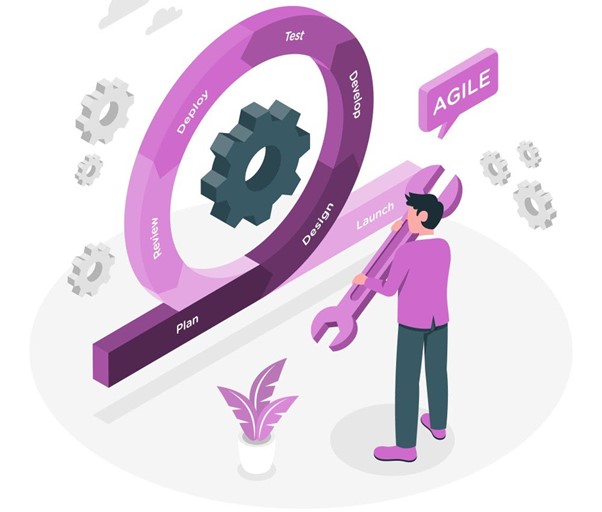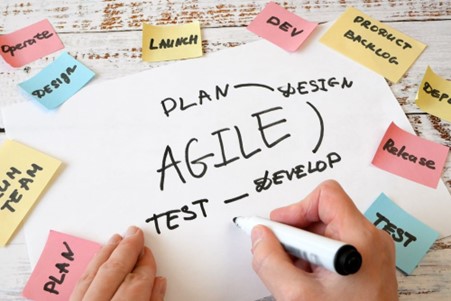The meaning and role of iteration in project management
In the world of project management, the term 'iteration' is often used. This is a basic principle of agile development, whereby a project is broken down into smaller, more manageable chunks of time. Many people associate iteration with software development, but it can also be used in many other areas. In this article, we look at what iteration means. What the iteration model looks like, what segments it can be used in, and its advantages and disadvantages.

The meaning of iteration
The concept of iteration in agile development refers to the timeframe during which development takes place, with the goal of producing a working, demonstrable increment.
The duration of the iteration can vary from project to project, usually between 1 and 4 weeks.
In agile development, the project consists of a series of iterations, preceded by a very short 'vision and design phase' before development, and topped by an equally short 'close-out phase'.
Iterations are usually aligned to calendar weeks. In most cases they start on Monday and end on Friday. However, many people follow this purely for convenience rather than as an explicit recommendation. Sometimes project teams follow other conventions.
Interesting fact: In scrum, iteration was originally used as 'sprint', but nowadays you see both terms. The Extreme Programming framework refers to iterations as 'weekly cycles'.
The concept of iteration: some important milestones
- In the 1970s, James Martin introduced the Rapid Application Development (RAD) methodology and linked the concept of iteration to timing. RAD focuses on the rapid development of applications through frequent iterations and validations, with continuous customer feedback.
- In 1995, the earliest writings on Scrum introduced the concept of a "sprint" as an iteration, although its duration varies.
- In 1998, the first papers on Extreme Programming (XP) describe fixed-length, three-week iterations and emphasise the benefits of this scheme.

What is iterative project management?
Iterative project management draws inspiration from agile and scrum project management methods, which use an iterative series of tasks with a fixed timeframe to break large projects into smaller, more manageable tasks.
What is the purpose of iterations?
Each iteration is designed to deliver a finished result or product, with sufficient space between iterations to gather feedback from customers or stakeholders for the next iteration. It is also important that the plans are flexible enough to be modified between iterations if necessary.

Steps in the iterative process
Now let's see what the process looks like in practice!
1. Design and requirements
A project plan is defined in line with the project objectives. At this stage, the requirements that need to be met in order to define the iterations and ensure the success of the project should be defined.
2. Analysis and planning
This step focuses on the business needs and technical requirements of the project. A plan is made to achieve the objectives.
3. Implementation
In the third step, the team creates the first iteration of the part of the project to be implemented. This is prepared and grounded in analysis and planning and should work to achieve the end goal of the project. The level of detail and the amount of time spent on this iteration will always depend on the project.
4. Testing
The iteration must also be tested. If you are working on improving a website, for example, it is a good idea to A/B test against your current website. If you're developing a new product or feature, it's worth usability testing with a range of potential customers.
In addition to testing, it is also recommended to consult with project stakeholders and ask for their feedback.
In which areas can the iteration process be applied?
Now let's look at some segments where the iteration model works!
Programming, development processes
Many engineering teams use iterations to develop new features, implement bug fixes or A/B test new strategies. Often, they create different iterations that they think are equally promising and then test them with users. This way they can assess the critical points and what was successful and build on the one that tested best.
Product development
Perhaps surprisingly, most product development is iterative. Think of the evolution of mobile phones over the years, for example, how the size and functionality of mobile phones has changed. Or how the same brand of refrigerator has been adapted to new family needs over the years. These are all iterative processes.
Marketing
Some marketing teams accept iterative processes, others are not particularly sympathetic to them. But to some extent, much of marketing is iterative. Some teams, for example, test different advertising copy to see which is more effective with their target audience, or send out two or more versions of a newsletter by email to compare click-through rates. Iterative design processes can also be used to identify the imagery that works best for the target audience.
Sales
Although much of the work of sales teams is not iterative, some of their tasks can benefit from iterative processes. For example, they can take an iterative approach to sending cold emails. They can create emails with different subjects and analyse the results. This way they can use the most successful version in their campaigns.
Advantages and disadvantages of the iterative model
The iterative model is not right for every team - or project. Let's now look at the main positives and negatives of the iterative process.
Benefits
- Increased efficiency - Because iterative processes involve trial and error, they can also help you achieve the desired result faster than non-iterative processes.
- More effective cooperation - Instead of working to predefined plans and specifications, which take time to prepare, the team members need to work together actively.
- Better adaptability - As more and more experience and information is brought to the fore during the implementation and testing phases, the iteration can be modified to achieve the goal. It may even be necessary to incorporate something that was not anticipated at the start of the iterative process.
- Cost-effectiveness - If the scope of the project needs to be changed, only minimal time and effort should be invested in the process.
- Possibility to work in parallel - Unlike other non-iterative methods, such as the waterfall model, iterations do not necessarily depend on the workflow that preceded them. This allows team members to work in parallel on multiple elements of the project, which can shorten the overall timeline.
- Lower risk - In the iterative process, risks are identified and addressed in each iteration. Rather than high risks being addressed at the beginning and end of a project, low risks are addressed on an ongoing basis.
- More reliable user feedback - If there is an iteration that users can see and try, they can give continuous feedback on what works for them and what doesn't.
Disadvantages
- Increase in scope - Iterative processes have the risk that the project may evolve in directions not previously anticipated and may exceed the scope of the original project.
- Inflexible design and requirements - The first step in the iterative process is to define the project requirements. Changing these requirements in the meantime can interrupt the workflow and create iterations that do not serve the purpose of the project.
- Vague deadlines - Since team members create, test and revise iterations until they reach a satisfactory solution, the iterative timeline is not clearly defined. Moreover, different increments of testing may have different lengths, which also affects the overall length of the iterative process.
Agile trends are gaining ground in projects and in the life of organisations. Develop your practical toolbox and gain international qualifications! Deepen your knowledge in our agile training courses!

 Designabc
Designabc